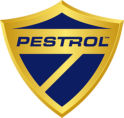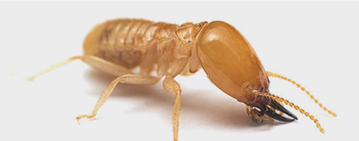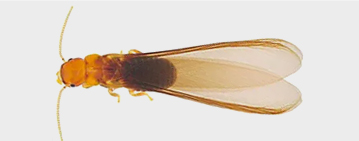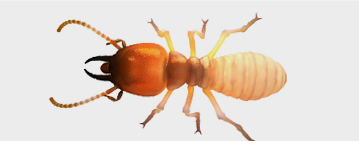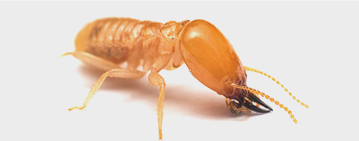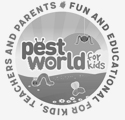INfomation about
Termites
A small
Intro about Termites
Termites can be difficult for residential and commercial properties to control in NYC & NJ. Having a professional pest control company that specializes in serving New York and New Jersey is essential to a long term Termites control solution that provides peace of mind.
Subterranean Termites
Family Rhinotermitidae
Overview:
Subterranean termite colonies are organized into castes depending on tasks – workers, soldiers and reproductives. The characteristics of a subterranean termite are dependent on the termite’s role in the colony. Worker subterranean termites are ¹⁄₈ to ³⁄₈ inch long. Soldier subterranean termites are of a similar body length, but are distinguished by their powerful mandibles and large brown heads. Reproductive subterranean termites are approximately ½ inch long.
Habits:
Subterranean termites live in underground colonies or in moist secluded areas above ground. They build distinctive “mud tubes” to gain access to food sources and to protect themselves from open air. Like other termite species, they feed on products containing cellulose. Subterranean termites swarm in the spring when groups of reproductive termites go off to start new colonies.
Threats:
Subterranean termites are by far the most destructive termite species. The hard, saw-toothed jaws of termites work like shears and are able to bite off extremely small fragments of wood, one piece at a time. They can cause severe property damage.
Prevention:
- Divert water away from your home’s foundation with properly functioning downspouts, gutters and splash blocks. Repair leaking faucets, water pipes and AC units on the outside of the home
- Reduce humidity in crawl spaces, attics and basements with proper ventilation
- Store firewood at least 20 feet away from the house and 5 inches off the ground.
- Keep mulch at least 15 inches from the foundation.
- Routinely inspect the foundation of your home for signs of mud tubes, cracked or bubbling paint and wood that sounds hollow when tapped.
- If you suspect a termite problem, contact a licensed pest professional right away
Did you know? Subterranean termites…
- live in colonies with as many as two million members.
- use their scissor-like jaws to eat wood 24 hours a day, seven days a week.
- and other termite species cause a collective $5 billion in property damage each year.
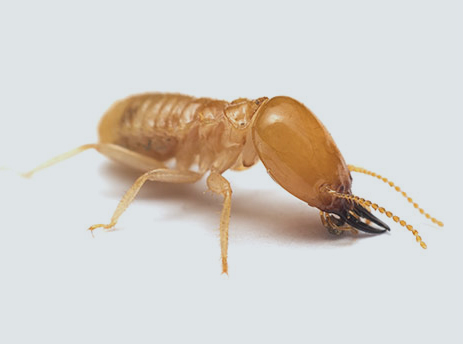

Color:
Creamy white to darkbrown/black
Shape:
Long, narrow and oval
Size:
1/8 inch long
Region:
Found throughout the U.S.Packages For Termites Protection
Save Money Today
up to $75 OFF
If you are a new customer, enjoy $75.00 off your Home Pest Protection Premium plan.
Coupon Code: HomePre22

Call & Get Your Free Estimate
855-737-8765
Drywood Termites
Family Kalotermitidae
Overview:
Drywood termites are social insects. They infest dry wood, like that found in attic framing. Unlike most termite species, drywood termites do not require contact with the soil. Swarming drywood termites fly into structures and infest wood directly.
Habits:
Drywood termites form colonies of up to 2,500 members. Unlike subterranean termites, drywood termite colonies do not have a worker caste. The work is done by immature termites before they reach adulthood
Threats:
Drywood termites can infest structures and cause significant structural damage. They can chew through support beams, floors and walls, causing expensive repairs.
Prevention:
- Avoid wood-to-ground contact around the perimeter of your home.
- Routinely inspect your home for signs of drywood termites. Pay special attention to window/door frames, trim, eaves, siding and attics.
- If you suspect a termite problem, contact a licensed pest professional right away.
Did you know? Drywood termites…
- can be transported to new locations via an infested piece of furniture, a picture frame, etc.
- usually swarm on sunny, warm days after a sudden rise in temperature.
- and other termite species cause a collective $5 billion in property damage each year.
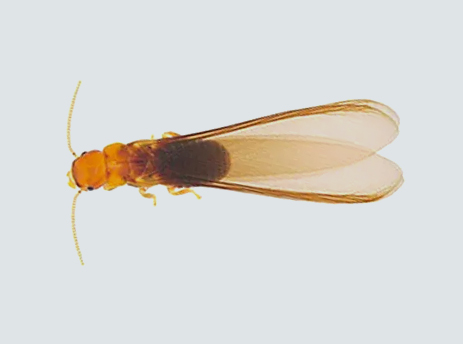

Color:
Creamy white to light brown
Shape:
Long, narrow and oval
Size:
3⁄₈ – 1 inch long
Region:
Primarily found coastally from South Carolina westward to Texas and up the west coast of CaliforniaCall & Get Your Free Estimate
855-737-8765 or
Dampwood Termites
Family Hodotermitidae
Overview:
As the name suggests, dampwood termites infest wood with a high moisture content. Dampwood termites are normally larger than other termite species. Bodies of king and queen dampwood termites range in size from ½ inch to ⁵⁄₈ inch long and have two pairs of wings that are equal in size and shape, extending beyond their abdomen. Nymphs can be as long as ⁵⁄₈ inch and worker dampwood termites are up to ¾ inch in size.
Habits:
Dampwood termite colonies, like drywood termites, have no worker caste. The nymph dampwood termites take care of the kings and queens of the colony and feed the soldier caste. Drywood termites are usually found in logs, stumps, dead trees, fence posts and utility poles.
Threats:
Because of their need for excessive moisture, dampwood termites are not often found in structures. However, these termites will infest sound wood if moisture is maintained, especially where wood is in contact with the ground or there is a moisture supply such as a leaky pipe. Care must be taken to avoid attracting dampwood termites to a structure as they can cause serious property damage.
Prevention:
- Eliminate sources of moisture by diverting water away from your home’s foundation with properly functioning downspouts, gutters and splash blocks. Repair leaking faucets, water pipes and AC units on the outside of the home.
- Reduce humidity in crawl spaces, attics and basements with proper ventilation.
- Store firewood at least 20 feet away from the house and 5 inches off the ground.
- Keep mulch at least 15 inches from the foundation and avoid wood-to-ground contact.
- Replace any damp or damaged wood on your home’s exterior.
- If you suspect a termite problem, contact a licensed pest professional right away
Did you know? Dampwood termites…
- eat wood across the grain.
- create a series of chambers in wood, which are connected by tunnels with smooth walls, as if sandpapered.
- and other termite species cause a collective $5 billion in property damage each year.
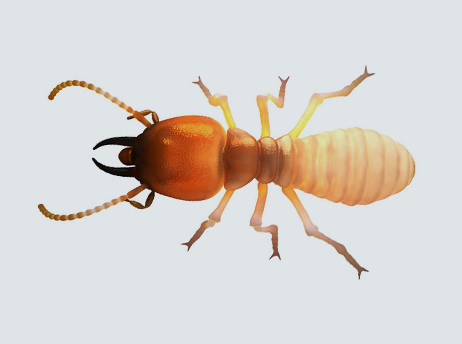

Color:
Creamy white to brownish
Shape:
Long, narrow and oval
Size:
¹⁄2 – 5⁄₈ inch long
Region:
Found throughout the pacific coastal and adjacent states, the desert or semi-arid southwest, and southern FloridaCall & Get Your Free Estimate
855-737-8765 or
Formosan Termites
C. formosanus
Overview:
Originally from China, Formosan termites are an extremely aggressive and destructive termite species. Formosan termites are a subterranean species of termite. Swarmer Formosan termites are about ½ inch in overall length, including their wings.
Habits:
Formosan termites live in huge underground colonies, with an average of 350,000 workers, but can contain as many as several million termites. Formosan termites build intricate mud nests in the ground. In addition to structures, they are also known to infest trees, shrubs, utility poles, timber, railroad trusses and even boats.
Threats:
A mature colony of Formosan termites can cause severe structural damage to a home in as little as six months. Prevention is key with this species. If dealing with an existing infestation, talk to a pest professional about Formosan termite treatment.
Prevention:
- Divert water away from your home’s foundation with properly functioning downspouts, gutters and splash blocks.
- Reduce humidity in crawl spaces, attics and basements with proper ventilation.
- Store firewood at least 20 feet away from the house and 5 inches off the ground.
- Maintain a one-inch gap between soil and wood portions of your home.
- Inspect your home for signs of mud tubes, bubbling paint and wood that sounds hollow when tapped.
- If you suspect a termite problem, contact a licensed pest professional right away.
Did you know? Formosan Termites
- are nicknamed the “super termite” for their destructive capabilities.
- of an average colony size can consume one foot of 2X4 wood in 25 days.
- can chew through wood, flooring and even wallpaper.
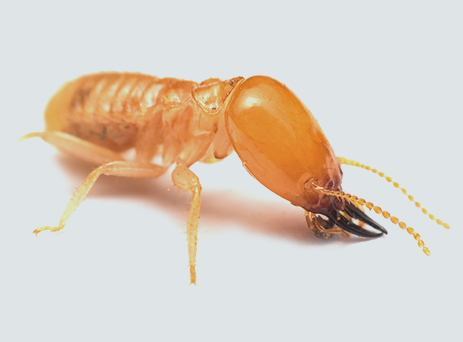

Color:
Creamy white to brown
Shape:
Long, narrow and oval
Size:
1/2 inch long
